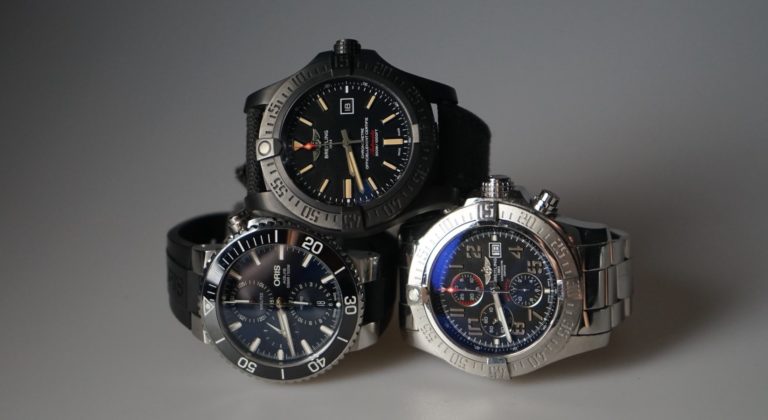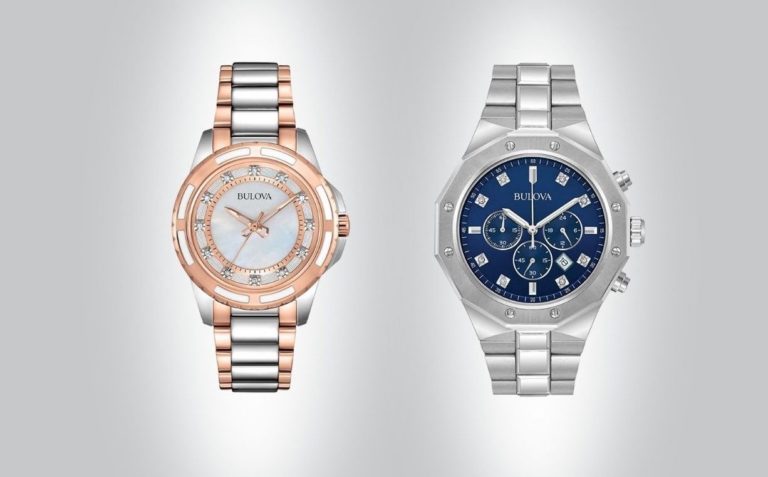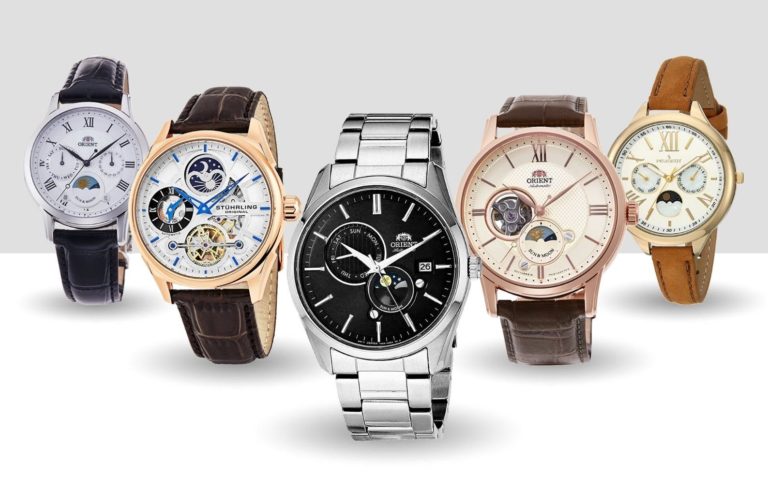Affiliate Disclosure: As an Amazon Associate I earn from qualifying purchases. Details
A moonphase watch was first introduced as early as 1925 by Swiss luxury brand Patek Philippe. That makes it one of the oldest watch complications with nearly a hundred years of existence.
The complication is also highly appreciated due to its complex construction and eye-catching appearance. As a result, moonphase watches aren’t the cheapest types of watches around.
But what is a moonphase watch after all? And how does it actually work?
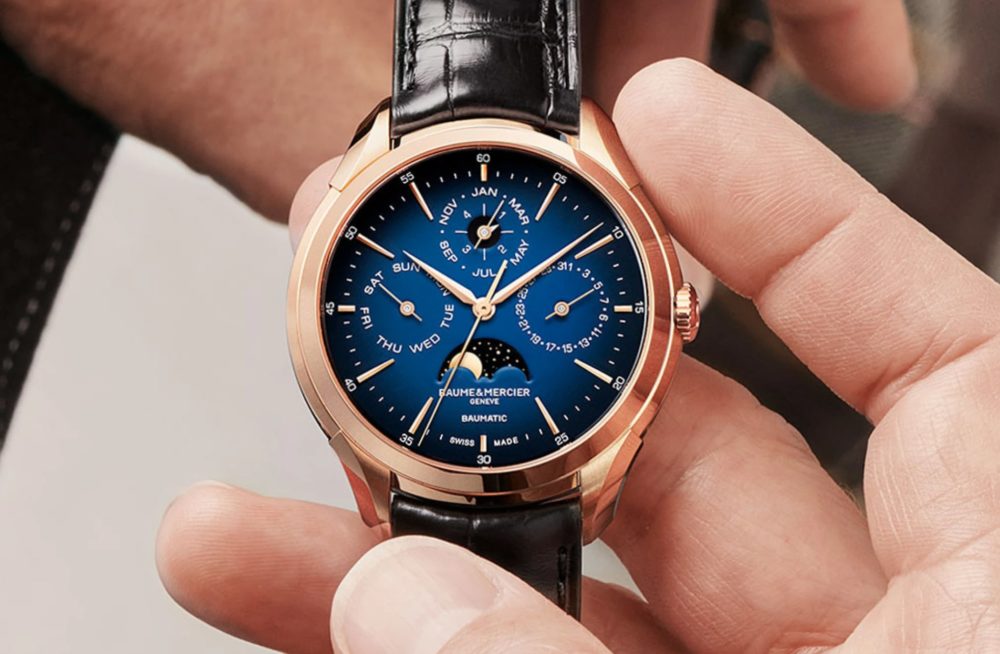
Following, we will delve into this unique watch complication to find out everything you should know about moonphase watches.
Also, feel free to check our shortlist of the best men’s moonphase watches in various price categories.
What Is A Moonphase Watch?
First off, let’s start with the basics – by explaining the term.
A moonphase watch is a timepiece that depicts the sunlit portion of the Moon (different phases) through a small aperture on the dial.
In case you’ve forgotten the science you studied at school, the Moon orbits the Earth, and it takes 29.5 days for the Moon to make the full lunar circle.
During that 29.5-day journey, the Moon is first entirely hidden between Earth and the Sun (New Moon), then starts to grow (waxing crescent and gibbous), becomes entirely visible (Full Moon), and finally wanes (waning gibbous and crescent).
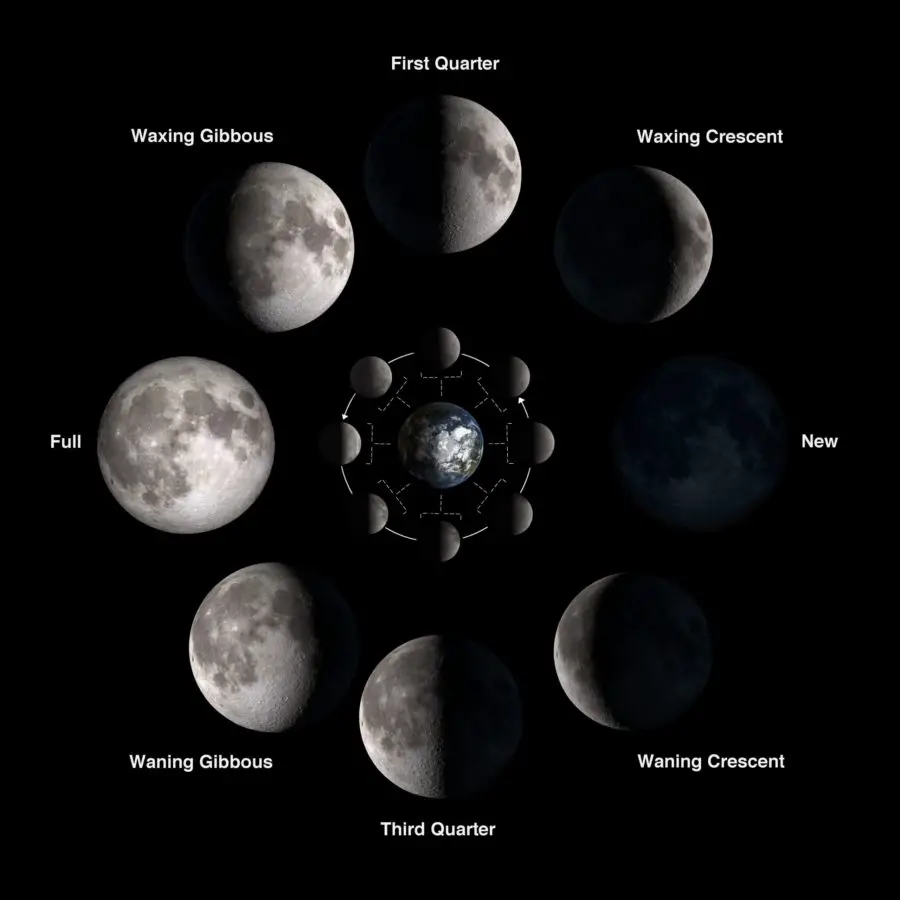
All these phases are all depicted on a moonphase watch.
2 Types of Moonphase Watches
There are two types of moonphase watches – bosom and radial.
1) Bosom – this is the most widespread type that got its sensual name from the shape of the aperture. The two humps graphically represent the Earth, enabling the watch depict the waxing and waning phases.
2) Radial – such a watch doesn’t have the crescent-shaped aperture but has a full circle instead where the different phases are indicated by a watch hand or an arrow.
There are also some extra unique designs and working mechanisms, such as the one of the Panerai L’Astronomo, where an overlapping disc shows the phases. However, these are extremely rare to find.
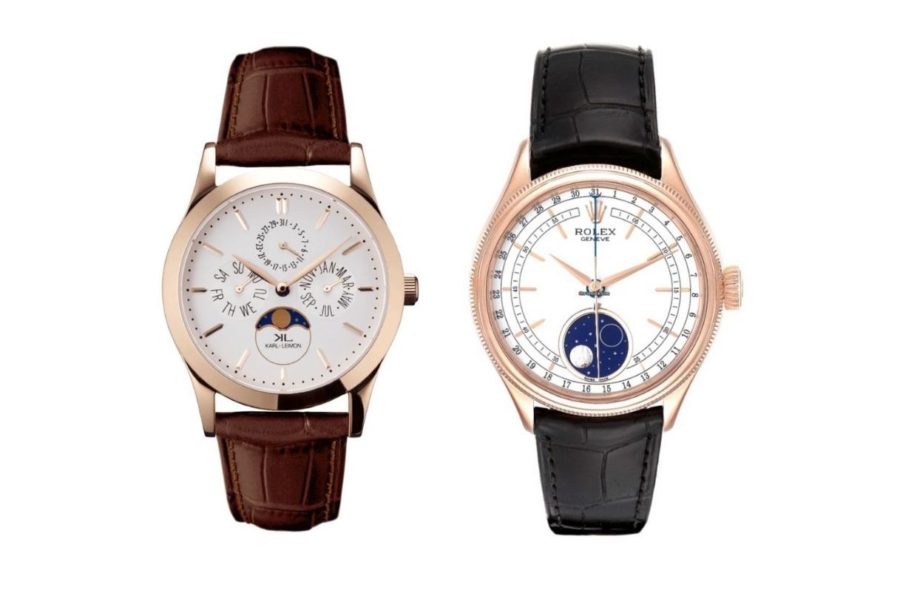
How Does a Moonphase Watch Work?
The overall story of these watches is so far pretty clear – they depict the phases of the moon and come in either crescent or circle-shaped.
However, it becomes a bit more complicated when it comes to the working mechanism (just like it is with any mechanical construction).
For the watch to depict the full lunar circle, it has two identical moons on a disc – each for the 29.5-day cycle. What makes the disc move is a mechanical finger that advances the disc once a day. In order for the disc to make the full circle (two cycles), it comes with a 59-tooth driving wheel (29.5 x 2 = 59).
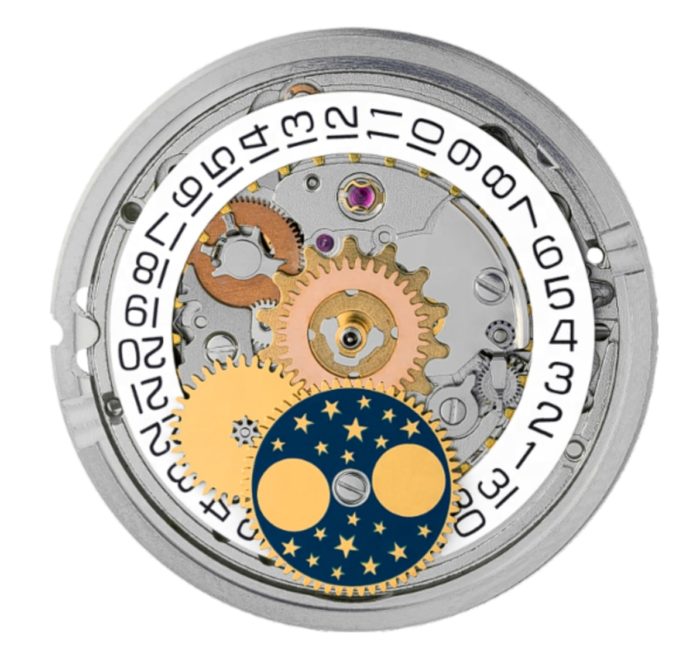
So, to put it simply, a moonphase complication is a 59-tooth wheel that consists of two moons and advances once every 24 hours.
When it comes to the radial moonphase watch, it has the same 59-tooth driving wheel that advances once per day. However, instead of the two moons on a disc, it has a hand that indicates the phases on a static circle.
The Concerns About the Accuracy
Although the construction of the complication is quite genius, it still has a considerable drawback – accuracy.
What causes the problem is the fact that the full lunar cycle doesn’t happen exactly in 29.5 days. Instead, the cycle repeats itself every 29 days, 12 hours, and 44 minutes.
It means the watch is off by 44 minutes every month, or 8 hours and 48 minutes per year. So it takes three years for the complication to be off by a full day.
As a result, the watch requires adjustment by one day forwards every three years to follow the correct lunar cycle.
However, since most wearers don’t rely on the exact moon phases in their day-to-day lives anyway, the inaccuracy won’t be much of a problem.
If you are still worried about it, you can check out astronomical moonphase watches. With these watches, the accuracy is an astonishing one day in thousands of years. And, quite obviously, you would have to fork out tens and even hundreds of thousands of dollars to get hold of one.
Adjusting the Moonphase Watch
Since a moonphase watch requires adjusting pretty often, it is important to know the exact procedure.
Unfortunately, it’s not as simple as setting the date or changing the time. Also, the procedure slightly differs from manufacturer to manufacturer.
However, the following steps should apply to most mechanical moonphase watches.
1. Set the hands at 6.30 to avoid damaging the mechanism
2. Check the current phase of the moon from the Internet
3. Push the dedicated button on the side of the case until the moon reaches the full moon position on the aperture
4. Push the button as many times as there are days that have passed from the last full moon
5. Set the date one day behind and then correct the time by going clockwise
Again, the procedure may be somewhat different from one watch to another. Therefore, make sure to check the instructions of the corresponding watch model.
Why Are Moonphase Watches So Expensive?
At its core, a moonphase watch doesn’t seem anything super complicated to a first-time watch wearer. The only addition compared to classic watches is a disc with two moons, and that’s about it.
Regardless, these watches have a starting price of $500, with the average valuation staying at several thousand.
So, what makes these watches so expensive, then?
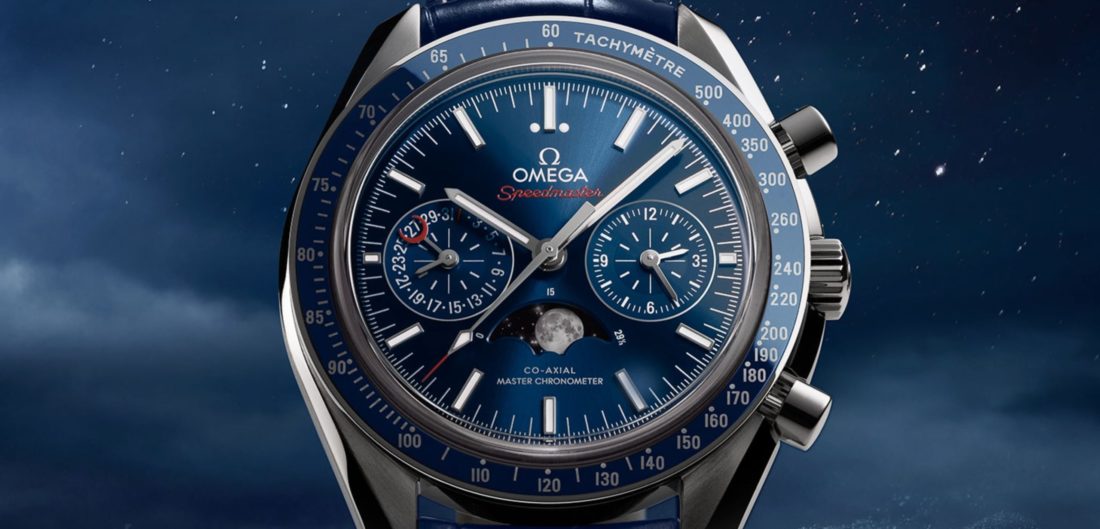
Several reasons are contributing to the high price of these watches. The very first reason is to do with the fact that most moonphase watches are automatic mechanical timepieces.
Those aware of the complexity of automatic watches know that adding complications means adding extra gears and wheels to an already sophisticated and complex mechanism. As a result, it takes more time to construct, which inevitably raises the price.
Another reason is the fact that the moonphase complication has the aura of something luxurious, meaning that watch manufacturers can inflate the price by some margins.
Finally, since there are not many moonphase watches produced by affordable watch brands, the average price rises at the expense of luxury brands, such as Omega, Patek Philippe, and Baume & Mercier.
Sun & Moon Watches – A Cheaper Alternative
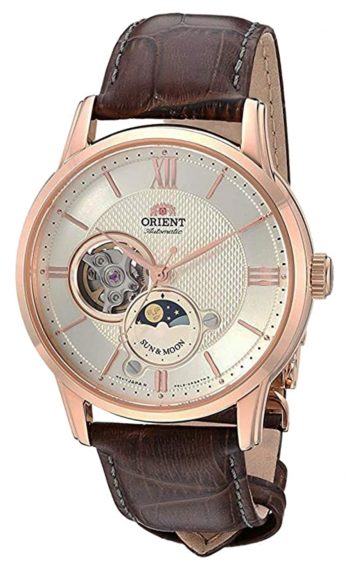
It is clear that paying thousands for a moonphase watch is a decision you don’t make in hours. And for many of us, it is a far reach dream anyway to own a luxury moonphase timepiece.
Fortunately, there is a much cheaper option available, called the Sun and Moon watch.
Such a timepiece looks very much like the moonphase watch, but instead of the 59-tooth disc with two moons, it has a disc with the moon and the sun.
The watch works pretty much like an AM/PM watch when the sun is on display during the day and the moon at night.
Sun and Moon watches have price tags anywhere between $100 and $400 and come from various manufacturers, including Orient, Stuhrling, and Peugeot.
Quartz Versions
The moonphase feature is also available in quartz watches.
Although quartz-driven timepieces aren’t as appreciated as automatic watches, the moonphase feature looks equally posh on any watch, regardless of the powering method.
However, despite the inferior prestige, quartz moonphase watches have a very significant advantage over their automatic counterparts. Namely, the watches won’t stop when not being worn for a couple of days.
What it means is that you don’t have to adjust the moonphase feature not until the battery runs out, which is typically in 2-3 years. Apparently, it also conveniently coincides with the accuracy-based corrections you would have to make anyway.
With an automatic watch, however, you would have to set the time, the date, AND the phase of the moon every time the watch runs out of energy.
Therefore, a quartz watch suits the best for those not wearing the watch every day, whereas an automatic moonphase watch is best to be worn daily, or at least be kept in a watch winder when not worn.
You can discover other underlying differences between these two types of movements from our quartz vs. automatic comparison.
Final Take
So, what is a moonphase watch, and should you go for it?
To conclude it within one sentence, a moonphase watch is a luxurious-like timepiece that is sophisticated, looks expensive, and brings this amazing celestial body right to your wrist.
If you appreciate the aesthetic side of this watch complication, there’s absolutely no reason not to go for a moonphase watch, especially considering the high-profile names producing such timepieces.
Fortunately, for those limited on budget, there are quartz options, as well as Sun & Moon watches, that won’t cost as much as automatic models that can often have price tags of several thousands of dollars.
Whatever your budget and preference, the appearance of a moonphase watch is something that won’t go unnoticed in the crowd.
You may also like:
Affiliate Disclosure: As an Amazon Associate I earn from qualifying purchases. Details
- CIGA Design Blue Planet Gilding Watch: The Best Conversation Starter Around? - April 2, 2023
- CIGA Design X-Series Review: The Most Skeleton for the Money? - July 7, 2022
- What Is A Dive Watch? A Complete Guide - May 17, 2022

